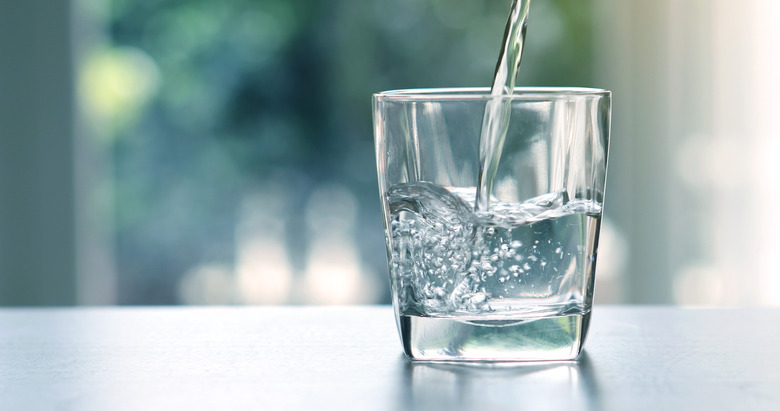What Intermolecular Forces Are Present In Water?
The H2O water molecule is polar with intermolecular dipole-dipole hydrogen bonds. As the water molecules attract each other and form bonds, water displays properties such as high surface tension and a high heat of vaporization. Intermolecular forces are much weaker than the intramolecular forces that hold the molecules together, but they are still strong enough to influence the properties of a substance. In the case of water, they make the liquid behave in unique ways and give it some useful characteristics.
TL;DR (Too Long; Didn't Read)
Water has strong hydrogen bond dipole-dipole intermolecular forces that give water a high surface tension and a high heat of vaporization and that make it a strong solvent.
Polar Molecules
Polar Molecules
While molecules have a neutral charge overall, the shape of the molecule may be such that one end is more negative and the other end more positive. In that case, the negatively charged ends attract the positively charged ends of other molecules, forming weak bonds, A polar molecule is called a dipole because it has two poles, plus and minus, and the bonds polar molecules form are called dipole-dipole bonds.
The water molecule has such charge differences. The oxygen atom in water has six electrons in its outer electron subshell where there is room for eight. The two hydrogen atoms in water form covalent bonds with the oxygen atom, sharing their two electrons with the oxygen atom. As a result, of the eight available bonding electrons in the molecule, two are shared with each of the two hydrogen atoms leaving four free.
The two hydrogen atoms stay on one side of the molecule while the free electrons gather on the other side. The shared electrons stay between the hydrogen atoms and the oxygen atom, leaving the positively charged hydrogen proton of the nucleus exposed. This means that the hydrogen side of the water molecule has a positive charge, while the other side where the free electrons are has a negative charge. As a result, the water molecule is polar and is a dipole.
Hydrogen Bonds
Hydrogen Bonds
The strongest intermolecular force in water is a special dipole bond called the hydrogen bond. Many molecules are polar and can form bipole-bipole bonds without forming hydrogen bonds or even having hydrogen in their molecule. Water is polar, and the dipole bond it forms is a hydrogen bond based on the two hydrogen atoms in the molecule.
Hydrogen bonds are especially strong because the hydrogen atom in molecules such as water is a small, naked proton with no inner electron shell. As a result, it can get close to the negative charge of the negative side of a polar molecule and form an especially strong bond. In water, a molecule can form up to four hydrogen bonds, with one molecule for each hydrogen atom and with two hydrogen atoms on the negative oxygen side. In water, these bonds are strong but are constantly shifting, breaking and re-forming to give water its special properties.
Ion-Dipole Bonds
Ion-Dipole Bonds
When ionic compounds are added to water, the charged ions can form bonds with the polar water molecules. For example, NaCl or table salt is an ionic compound because the sodium atom has given its sole outer shell electron to the chlorine atom, forming sodium and chlorine ions. When dissolved in water, the molecules dissociate into positively charged sodium ions and negatively charged chlorine ions. The sodium ions are attracted to the negative poles of the water molecules and form ion-dipole bonds there, while the chlorine ions form bonds with the hydrogen atoms. The formation of ion-dipole bonds is a reason why ionic compounds dissolve easily in water.
The Effects of Intermolecular Forces on Material Properties
The Effects of Intermolecular Forces on Material Properties
Intermolecular forces and the bonds they produce can affect how a material behaves. In the case of water, the relatively strong hydrogen bonds hold the water together. Two of the resulting properties are high surface tension and a high heat of vaporization.
Surface tension is high because water molecules along the surface of water form bonds that create a kind of elastic film on the surface, allowing the surface to support some weight and pulling droplets of water into round shapes.
Heat of vaporization is high because, once water reaches the boiling point, the water molecules are still bonded and remain a liquid until enough energy is added to break the bonds. Bonds based on intermolecular forces are not as strong as chemical bonds, but they are still important in explaining how some materials behave.
Cite This Article
MLA
Markgraf, Bert. "What Intermolecular Forces Are Present In Water?" sciencing.com, https://www.sciencing.com/what-intermolecular-forces-are-present-in-water-13710249/. 14 March 2018.
APA
Markgraf, Bert. (2018, March 14). What Intermolecular Forces Are Present In Water?. sciencing.com. Retrieved from https://www.sciencing.com/what-intermolecular-forces-are-present-in-water-13710249/
Chicago
Markgraf, Bert. What Intermolecular Forces Are Present In Water? last modified March 24, 2022. https://www.sciencing.com/what-intermolecular-forces-are-present-in-water-13710249/
